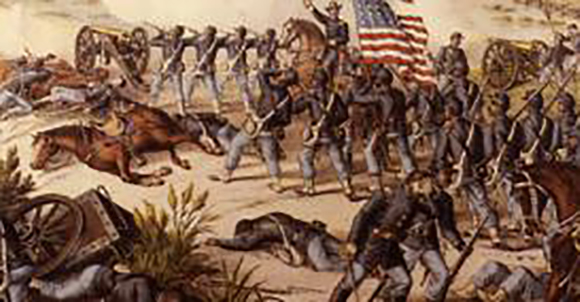VIDEO: Battle of Olustee Approaches 154th Anniversary, Florida’s Largest Civil War Battle
By Sunshine State News // February 18, 2018
battle of Olustee was fought on Feb. 20, 1864
ABOVE VIDEO: The Battle of Olustee was by far on of the largest battles that took place in the State of Florida, with roughly 5500 men on each side. Fought in the thick forest of tall pine trees men fell by the hundreds the battle ragged though out the day until the Union broke and began to retreat. In 1912, the Olustee Battlefield was named Florida’s first historic site.

(SUNSHINE STATE NEWS) – Civil War aficionados, sporting both the Union Blue and the Confederate Gray, will be gathering this weekend some 15 miles east of Lake City, in the middle of the Osceola National Forest and right off of I-10, to re-enact the battle of Olustee — the largest Civil War battle in Florida.
While there will be a parade and festival held in Lake City the entire weekend, the highlight will be the re-enactment of the battle which will be at the Olustee Battlefield Historic State Park on Sunday.
The battle of Olustee was fought on Feb. 20, 1864, when Union forces advancing from Jacksonville to take Lake City were defeated by a force of Confederates.
Almost 40 percent of the Union troops were casualties, compared to 20 percent of the Confederates. Three regiments of newly emancipated black troops, including the 54th Massachusetts regiment celebrated in the movie “Glory,” took part in the battle.
Of course, this being Florida — the state of hanging chads and the front lines of close presidential elections ranging from 1876 to 2000 — there were more than a few politicians involved in the fighting.

The Confederate forces were led by Joseph Finegan — a Floridian who was a leading figure in the state. A Nassau County political leader who was at the state secession convention in 1861 and a railroad promoter who was a partner with David Levy Yulee, Finegan later commanded the Florida Brigade in Robert E. Lee’s Army of Northern Virginia.
Finegan’s house on Amelia Island was taken during the war by the federal government — namely future Gov. Harrison Reed of the U.S. Treasury Department.
Reed pushed to turn Finegan’s house into a home and school for black orphans. The school was led by Chloe Merrick, an idealistic teacher from the North. Reed would later marry Merrick and embark on one of the stormiest political careers in Florida’s history.
Some scholars — and certainly more than a few contemporary observers — credited Georgian Alfred Colquitt with the Confederate victory at Olustee. A veteran brigade commander with Lee’s army who also saw service in North Carolina, Colquitt had been a congressman before the war and would serve as governor of Georgia and a U.S. senator after the war.
Needless to say, partisans of both leaders argued over who deserved credit for the victory. Even Alexander Stephens, the diminutive Georgian who served as Jefferson Davis’ vice president, could not resist entering the fray.
In “The Reviewers Reviewed,” his strange response to critics of his monumental but, alas, nearly unreadable, “A Constitutional View of the Late War Between the States,” Stephens praised both generals — but gave Colquitt more credit than Finegan for winning at Olustee.
The general leading the Union forces had an odd career of his own. Truman Seymour, the Union commander, was a member of the West Point class of 1846 which produced some of the leading generals of the war — Stonewall Jackson, George McClellan and George Pickett, for example.
Seymour, who had experience fighting the Seminoles in Florida in the 1850s, was not much of a general and, after losing Olustee, was relieved of command and sent to command a brigade in Virginia — and was captured by Confederate forces at the Battle of the Wilderness.
Seymour found his calling after the war. He had married the daughter of Robert Weir, his drawing instructor at West Point.
Fitting enough, Seymour ended up as close friends with one of Weirs students who failed out of West Point and ended up as an artist — James Whistler, creator of “Arrangement in Grey and Black No. 1” (commonly known as “Whistlers Mother”).
Seymour ended up in Europe painting watercolors after the war and is buried in a fitting location for artists — Florence, Italy.
CLICK HERE FOR BREVARD COUNTY NEWS














